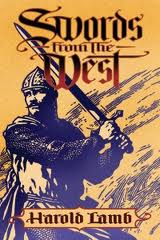Harold Lamb’s Adventure Fiction
 In discussion of my influences I always mention the writer Harold Lamb, but it’s a sad truth that he’s still little known today. That wasn’t always true. A few generations ago he was one of the most popular writers in one of the best (and most respected) of all pulp magazines, Adventure. Later in life his biographies and histories were award winning and well-regarded, and he was considered such an expert on the Middle-East that the state department sometimes consulted with him.
In discussion of my influences I always mention the writer Harold Lamb, but it’s a sad truth that he’s still little known today. That wasn’t always true. A few generations ago he was one of the most popular writers in one of the best (and most respected) of all pulp magazines, Adventure. Later in life his biographies and histories were award winning and well-regarded, and he was considered such an expert on the Middle-East that the state department sometimes consulted with him.
Once I discovered just how consistently excellent Lamb’s adventure fiction was it was my dream that it would be brought properly into print, and I am extremely proud to have been intimately involved in making that happen through the Bison Books imprint of the University of Nebraska Press.
There are several things that drew me to Lamb’s fiction. When I was young it was the headlong pace and the exotic settings, so exotic, as L. Sprague de Camp once wrote, Lamb might as well have been writing of Burroughs’ Mars. But Lamb wasn’t inventing his setting, he was enmeshed in a great deal of research at a time when detailed research meant mastering other languages and journeying to distant lands and libraries.
 Upon first discovering Lamb I thought I had discovered that lots of old fiction might be excellent, but years of my own research proved that mostly false. Occasional old adventure fiction is worth a read, but most of it is mired in its time. Lamb isn’t a standout with just one or two works, as might be expected, but with a large canon of fiction that is consistently good to excellent. His plotting and pacing feels surprisingly modern. His heroes are drawn from the east and west, and villainy can be found on either side of the cultural divide.
Upon first discovering Lamb I thought I had discovered that lots of old fiction might be excellent, but years of my own research proved that mostly false. Occasional old adventure fiction is worth a read, but most of it is mired in its time. Lamb isn’t a standout with just one or two works, as might be expected, but with a large canon of fiction that is consistently good to excellent. His plotting and pacing feels surprisingly modern. His heroes are drawn from the east and west, and villainy can be found on either side of the cultural divide.
Sure, I fell in love with the Arabian Nights, but I’m not sure I would have thought about writing any kind of stories with eastern protagonists if I hadn’t been immersed in Lamb’s work. I particularly loved the friendship between the two protagonists in his short story, “The Long Sword” (collected in Swords from the West). One is Sir John, a poor knight who owns a tiny tower in Palestine. His best friend is Khalil, a quick-witted Muslim warrior.
Here’s Khalil in a brief snippet of a scene, pretending to be Sir John to fool the pair’s enemies. Note the short, sharp way that Lamb sketches the scene and reveals character.
Khalil peered down uneasily. He did not know how many men might be awake down there in the gloom under the trees, and besides, he could see almost nothing at all because he had Sir John’s heavy battle casque on his head. And his left arm was already weary with the weight of Sir John’s long kite shield. From side to side he turned his head like an uneasy wolf, seeing only the red glimmer of campfires and the yellow points of stars overhead.
“May Allah confound this steel pot!” he swore.
We celebrate writers of other sorts of fiction here in the United States. Why don’t we celebrate one of our most gifted writers of historical adventure fiction? Anyway, it’s good stuff. Go read it, and tell your friends.
For a longer discussion of Lamb’s adventure fiction, including some lengthy excerpts demonstrating his excellence, visit my earlier essay about him, here.
For details about how I put the Harold Lamb books together for the University of Nebraska Press, visit here.
17 Comments